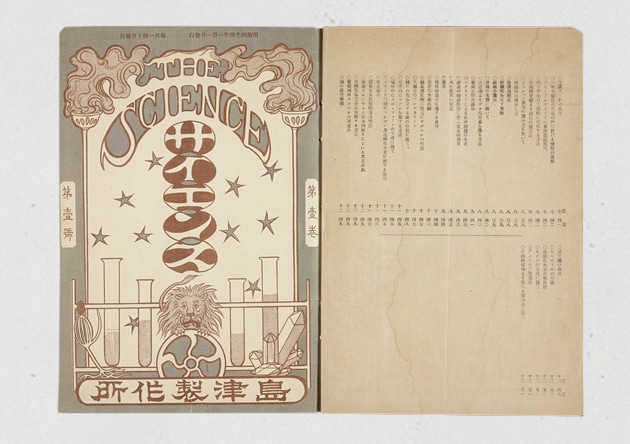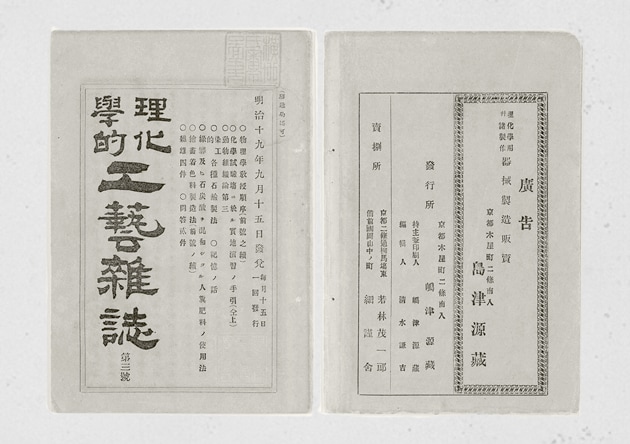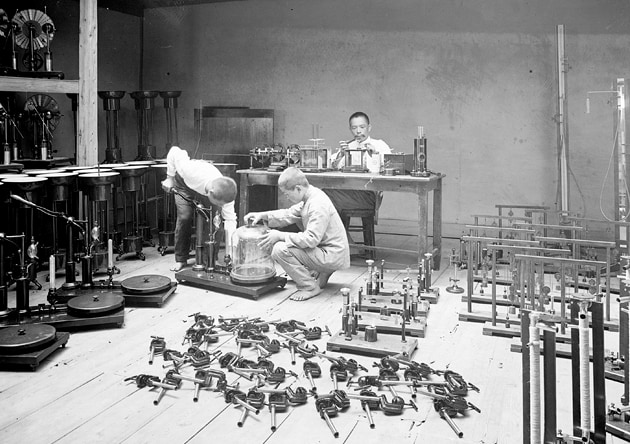vol.6
Thinking globally in the Meiji period
First issue of "Physics and Chemistry Industrial Arts Journal"
Shimadzu Corporation has a tradition of investing tremendous effort into promoting the widespread adoption of science and technology.
As a result, Shimadzu technical journal "Shimadzu Review", which was published from 1940 (Showa 15), clearly distinguished itself from all other journals in the field.
Though the name changed to "Science" at the end of the Meiji period and then to "Laboratory" in the Taisho and Showa periods, Shimadzu's passion for science and technology remained unchanged.
Its origin goes back to the Physics and Chemistry Industrial Arts Journal, first published by Genzo Shimadzu Senior in 1886 (Meiji 19).
Based on his conviction that "From now on, Japan must succeed based on science," Genzo Senior began manufacturing educational physics and chemistry instruments.

Genzo thought that the road to Japan becoming a leader in science was teaching the children of Japan, who represent Japan's future, how interesting and wonderful science can be.
In effect, it was a grass-roots movement to enlighten the nation.
Meanwhile, when he visited the nearby Physics and Chemistry Research Institute, Genzo was both enamored by the science he saw there and also pained by the overwhelming gap between the level of science in Japan and the West.
For Japan to catch up to the rest of the world, the Japanese public would need to be exposed to state-of-the-art science.
That inspired the first issue of "Physics and Chemistry Industrial Arts Journal."

Originally, Genzo Senior opened a science salon on the second floor of his home, named the "Physics and Chemistry Society."
Genzo had no formal training in science.
So, based on his approach of making things first and then figuring out the theory later, a major motivation for opening the salon was to hear many people's views on whether or not his thinking was correct.
Genzo was not a passionate speaker, but he was a naturally gifted listener.
Therefore, the salon served as a gathering place for up-and-coming scholars recently returned from studying overseas. Consequently, Genzo was exposed to a steady stream of information about the status of science in the West.
Everyone shared the same desire to "make Japan a leader in science."
Therefore, it was probably only natural that Genzo spearheaded efforts to publish a journal on science.

Genzo's sense of curiosity was also often evident in the Physics and Chemistry Industrial Arts Journal.
The journal included scientific papers from a wide variety of scientific genres.
In addition to mechanical and electrical engineering, of course, it also included papers involving chemistry, botany, zoology, fertilizer research, Western cooking methods, memory research, and even drugs for growing hair and methods for identifying fake wines.
A kind way to describe it is "all-encompassing," but a more honest description is "anything-goes."
On the other hand, it shows just how hungry not only Genzo, but all of Japan was for scientific knowledge during that period.
The fact that Shimadzu was able to publish such a scientific journal before Shimadzu Corporation was a large company, or even before the company had grown beyond being a small shop run by a sole proprietor, was only possible as a result of the collective passion of many people, rather than the efforts by Genzo alone.
Fifteen issues of the Physics and Chemistry Industrial Arts Journal, with an average of 35 pages per issue, were published in just over one year.
However, the focus of the journal went far beyond Shimadzu Corporation, as a single company, and represented a perspective of Japan in the context of the world.
It was just the global perspective typical of people in the Meiji period had in mind.
Due to the high scientific level of its content and noble views on science, the Physics and Chemistry Industrial Arts Journal is still considered a valuable academic resource today.
